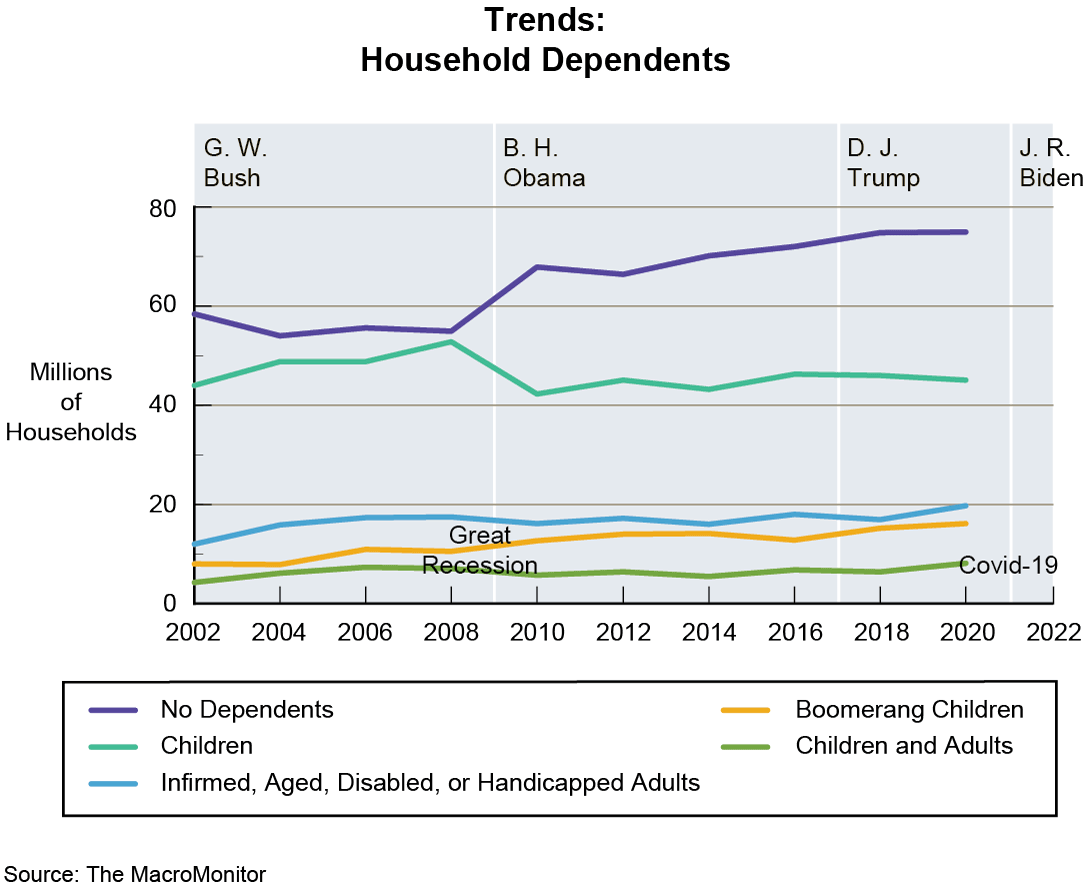Trends Newsletter April 2021
If you would like more information about this topic, please contact us.
Dependents

It's tax time! More families than previously are calculating how many dependents they can claim. There may be additions to their household (HH) such as the birth of a child, a young adults' return, or a mature adult's move into the nuclear-family home.
The structure of American families is evolving—sometimes by choice; sometimes because of economic necessity.
Many HHs have experienced a year like no other in living memory. The 2020 mortality rate grew by 14.6% over 2019; more than a half a million people have died from Covid‑19 alone. Pandemic news overshadows reports of the intensifying opioid epidemic with its devastating effects on families. In the past two years, 10.2 million households suffered a job loss; 7.2 million households experienced an income decrease of more than 25%. The US birth rate is the lowest in three decades: The Balance cites several factors responsible for the trend; the decline in teen pregnancies; delayed motherhood; and that almost one-third of young women desire to remain child-free. Of note: young women cite financial insecurity, the impact of motherhood on a career, and climate change most frequently as the cause. Caregiving demands and home-schooling responsibilities have reduced some two-earner households to single-earner households. Even with promising news about Covid vaccines, life is forever changed for all but (perhaps) the wealthiest HHs.
The top two lines (No Dependents and Children) in the chart below illustrate a very worrisome long-term societal trend—the explosion in the number of single-person HHs.

Of immediate concern are the ramifications of the bottom three trend lines in the chart. With the will to do so, these trends could be remedied, or at least mitigated, by government actions.
- The numbers of HHs that support infirmed, aged, disabled, or handicapped adults has increased by almost 8 million HHs in the past two decades. If dependents are eligible for government benefits such as Social Security, they may help to stabilize the household economically. However, any HH additions place more responsibility on (predominately) women if any amount of care is required. Yes, even shopping, food preparation, laundry, and cleaning count as a full-time, or second, job for women.
- The number of HHs with Boomerang children (young adults who have returned home but cannot be claimed as dependents) has increased by 8.2 million since 2002. Children aged 19 to 25 may be claimed as dependents if they are students. If employed, (many Boomerangs lost entry-level jobs in the first round of pandemic closures) they likely cannot be claimed as dependents, but are unlikely to be able to pay their share of HH expenses. The net result: more HH heads need to stop funding retirement accounts, dip into retirement savings to keep the expanded HH afloat, or delay retirement entirely.
- HHs that support both children and adults are particularly troubling; for many HHs the practice is not sustainable. The number of these households has almost doubled since 2002 to 8.1 million in our 2020 survey. HH's that support children and dependent adults' most distinctive feature is their attitudes. Similar to, but defined more specifically, are multigenerational HHs. The former may, or may not be three generations. Multigenerational HHs—not shown in the chart—are distinctive in their attitudes and by ethnicity.
Also not shown, but trending are HHs in which dependents skip a generation. Known as grandfamilies, grandparents are raising grandchildren in the absence of a biological parent. A 2020 study reported in Medical Express estimates that more than 2.5 million grandparents (individuals) are in grandfamilies. In addition to the societal effect, kinship care presents its own set of unique emotional and practical challenges, and economic impacts.
Reports about any of these different populations provide excellent demonstrations of the value of MacroMonitor's single-source data.
Additional deliverables are available to MacroMonitor subscribers:
- The April 2021 Stories: Multigenerational Households
- The underlying set of data for the April Stories (by request)
For more information, or to have a conversation, give us a call or shoot us an email to setup a time for a discussion. We're easy to reach.